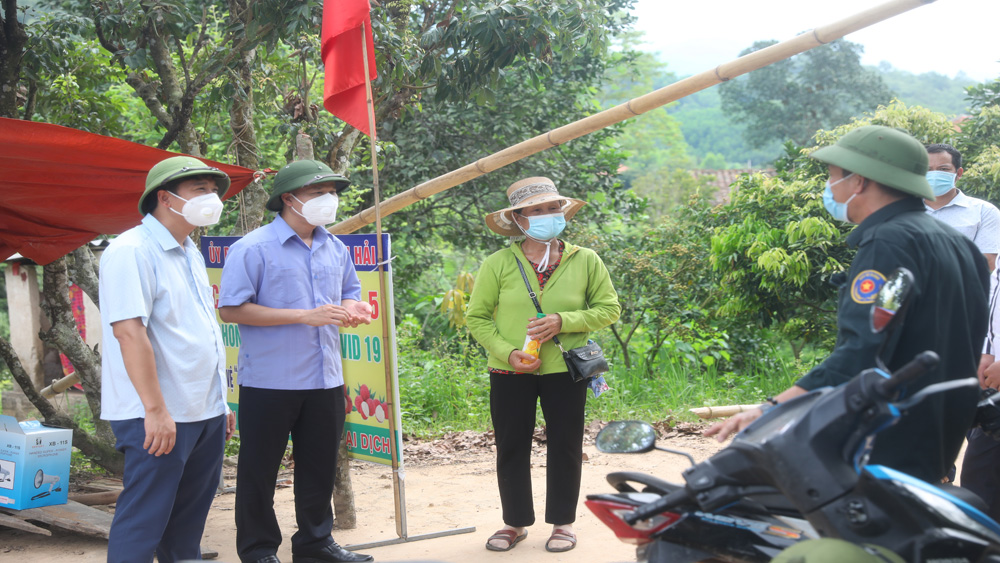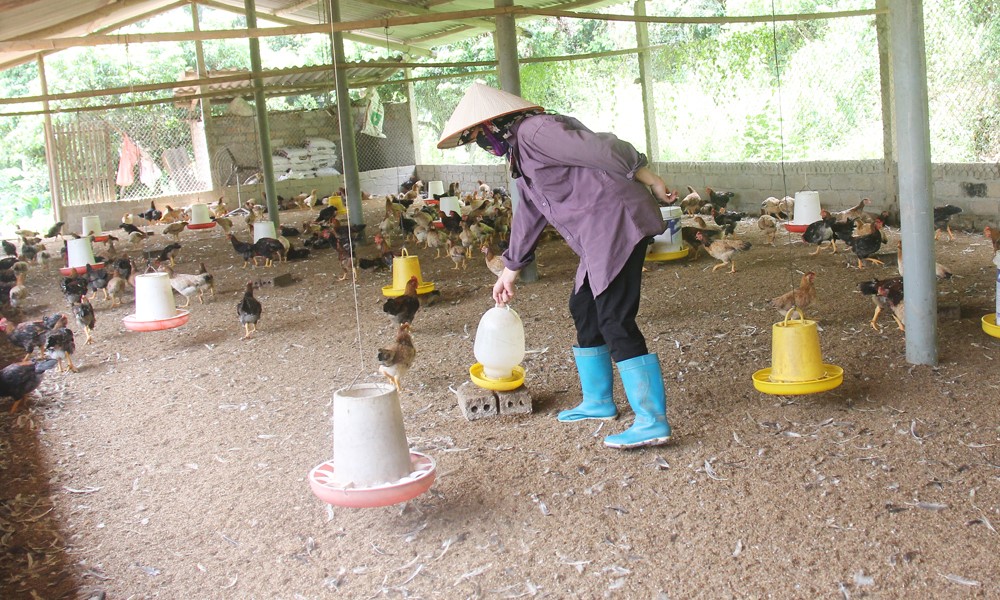Luc Ngan goes through the “hottest” days
Many drastic and creative measures
Facing the unpredictable developments of the Covid-19 epidemic, the province developed three scenarios for lychee sale. Luc Ngan district, with more specific and flexible requirements, built six scenarios, preparing for all the most difficult situations.
 |
|
Mai Son, Standing Vice Chairman of the provincial People's Committee (second from left) and Nguyen Viet Oanh, Secretary of the Luc Ngan district Party Committee inspects Covid-19 prevention and control in Dong Ma village, Son Hai commune. |
A “steel belt” was erected to protect the lychee area in the safest way. Thanks to measures to open the "green lanes" for lychee consumption, the early-ripening lychee of Luc Ngan was basically sold smoothly. However, entering the main crop, the "steel belt" was pierced by an outbreak in Bang Cong village, Kien Thanh commune on June 15, due to infection from the quarantine area. At that time, the district sold about 70,000 tonnes of lychees, accounting for 50 percent of its production.
The province's Front Command No.2 was established to direct epidemic prevention and control in Luc Ngan. With the motto of quickly stamping out the pandemic, ensuring the health of the people as the top priority, and supporting the quick selling of lychees, the anti-epidemic forces took many creative ways.
If in the "green area", taking samples for testing was conducted 1 to 2 times, in the "red area" it was done continuously 5 to 6 times, 2 to 3 days apart, and in the "yellow area" 3 to 4 times, 3 to 5 days apart. Based on these results, the Command made an epidemiological map, combined with the maps of the district's lychee regions and an administrative map, to determine areas for social distancing in the smallest scale, with the least effects on lychee sale.
For communes under lockdown, the harvesting was implemented in the principle of “each household harvests their own lychees, each person harvests a tree”. Farmers did not carry lychees to the purchase points, but trucks came to the gardens to collect lychees. The scenario of increasing dried lychee output was effective thanks to the district's support of 4 billion VND (173,700 USD) to build 2,000 new kilns, plus 1,000 old ones, which processed nearly one third of the output, considerably reducing pressure on fresh lychee sale. The lychee crop was shortened by 20 days compared to the previous year.
Lessons learned from this crop
After 2 weeks, the Front Command No. 2 and Luc Ngan district, with right, correct and timely measures, managed to control the epidemic. Thanks to zoning off affected areas at the smallest scale and stamping out the pandemic in the fastest way, the sale of lychees was not affected much. As a result, the whole district sold 145,000 tonnes, the highest ever volume, with the price of about 22,500 VND (0.98 USD) per kg. Revenue from lychee and ancillary services reached more than 4 trillion VND (173.6 million USD), equivalent to last year’s figure.
 |
|
Preliminary processing and packaging of Luc Ngan lychees before selling. |
The lessons learned by the Front Command No.2 and Luc Ngan district are closely following the directions of higher-level authorities, properly assessing the situation, effectively applying knowledge and experience in pandemic prevention and control, and thoroughly considering the imposition of measures, not locking down the whole district to implement the "dual goals".
It is necessary to promote communications on the mass media and uphold the role of mobile popularisation teams, community Covid-19 groups, and tracing teams.
Fighting the epidemic right in the lychee season faced numerous difficulties but Luc Ngan has overcome the "hottest" days. From the double victory of this year's lychee crop, valuable lessons on "controlling the pandemic to sell agricultural products, selling agricultural products to fight the pandemic" have been learned. That victory strengthened the people's confidence in the Party and authorities to join hands in step by step turning Luc Ngan district into a key fruit-tree area of the country.
 Bắc giang
Bắc giang
















Reader's comments (0)